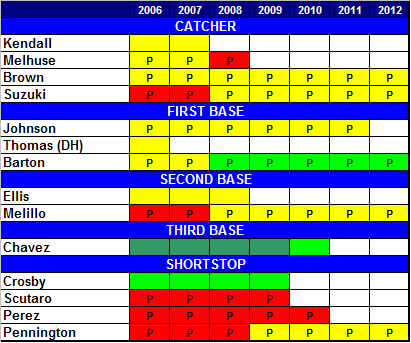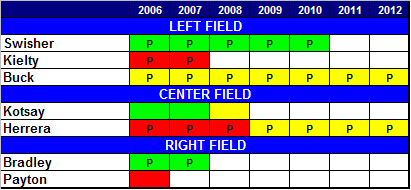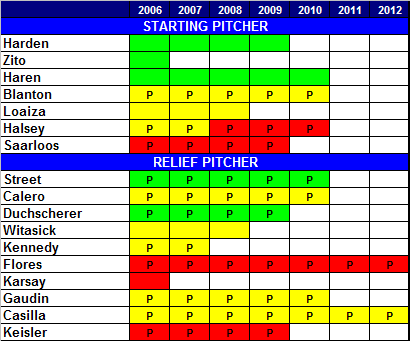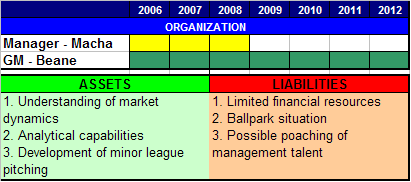My Tuftian analysis of the Cubs generated a lot of response. Most of this consisted of people asking if I could give their favorite club the once-over, too. So this week, we’ll look at another popular squad that has reached an early-season crossroads: the Oakland Elephants.

The A’s catching situation has the feel of “half dozen of one” and “six of the other, equaling less than twelve.” Jason Kendall has turned in a somewhat credible performance this season, but he is going to have trouble sustaining such a high isolated walk rate unless he can find his bat, and without those walks, he isn’t much of a player. Either Jeremy Brown or Kurt Suzuki could develop into a passable regular, but neither the scouts nor PECOTA see much star potential. That said, catcher is a particularly difficult position for a team like the A’s to develop because backstops come along slowly, so settling for an eventual .250/.325/.400 performance from someone like Suzuki may work here.
There is a relatively similar situation at second base with Mark Ellis and Kevin Melillo. I’m putting a lot of emphasis on Ellis’ slow start because he missed all of 2004 and had a shortened season in 2005–his 179 plate appearances on the season represent an unusually large portion of his relevant sample size.
Bobby Crosby is now 26 and has hit .247/.318/.421 over 1200 plate appearances in his major league career. PECOTA previously held out some hope that he’d be a late-bloomer, but that is becoming less likely by the day. He’s a good player, but he’s not the second cheap superstar that a team like the A’s may require.
Nor is Daric Barton likely to be That Player. These are Barton’s translated isolated slugging numbers since turning professional:
2003 Rookie - Johnson City .095 2004 A-Ball - Peoria .150 2005 High-A - Stockton .099 2005 Double-A - Midland .151 2005 AFL - Phoenix .105 2006 Triple A - Sacramento .114
I’ve listed Barton as inching into green territory since he’s still very young for his levels. But he isn’t considered to have a lot of “projectable” power, and right now he’s looking like the second coming of Doug Mientkiewicz.

The news is happier in the outfield, mainly because Nick Swisher has emerged as a guy who does have superstar potential. I am hedging just a little bit with Swisher because the bar is set pretty high for a slow corner outfielder, and because I don’t think he’ll continue to maintain a batting average close to .300 while striking out so much. But Swisher’s breakout is for real–he’s lofting the ball more frequently and adopting a somewhat more aggressive plate approach early in the count, just as we suggested in BP 2006. I think he settles in as a .255/.375/.550 guy and a perennial stathead favorite.
People have wondered aloud whether Milton Bradley is the second coming of Dick Allen; the better question may be whether he’s the second coming of J.D. Drew. Nevertheless, he’s never failed to produce when healthy, and he probably represents a better option for a team like the A’s that has solid outfield depth.

All of a sudden, the A’s starting pitching is not looking so deep. I rated Rich Harden as the 17th most valuable property in baseball only six weeks ago, but that was before he suffered yet another injury, this time a muscle strain in his back. I realize that Harden gets praise for his mechanics, but I can’t help but wonder if something is off-kilter here. In any event, I don’t see a whole lot of difference between Harden and Mark Prior, who received the same rating. Esteban Loaiza is the other near-term problem, although in Loaiza’s case it’s almost reassuring that he turned out to be injured since it helps to explain away his poor early performance.
Nor is there much pitching help in the upper minors–a consequence of the A’s having focused on hitting for several drafts in a row prior to 2005. Screwball specialist Dallas Braden has not pitched this year, and Dan Meyer‘s strikeout rate isn’t cutting it. There is better depth in the lower minors, but it’s going to take an awful lot for an A-ball pitcher to make this list, and pitchers like Jared Lansford haven’t shown a lot so far.
This analysis does overstate the depth problem somewhat since several pitchers on the relievers list–certainly Joe Kennedy, Chad Gaudin, and possibly Justin Duchscherer–could plausibly be used as starters. In fact, I don’t see why the A’s are giving Saarloos a turn every fifth day when someone like Gaudin could provide both near- and medium-term benefits. Nevertheless, moving Barry Zito is a much riskier move than it appeared at the start of the season, and given Zito’s popularity in the Bay Area, the A’s may need to think seriously about re-signing him.

If the A’s had an investment prospectus, one of the risks that a potential buyer would focus on is that a great amount of their value is tied into their ability to retain certain key personnel, e.g. Billy Beane. We know that Beane turned down big money from the Red Sox a couple of years ago but that is when his club was coming off a 96-66 season. If a team like the Yankees or Cubs calls after the A’s finish at 80-82, the result could be different. Nor are the A’s drawing well–they’re on pace for attendance of just 1.85 million this season, in spite of having already played their home series against the Yankees and Giants. Being the second team in a two-team market is precarious if you aren’t playing well enough to pull in the requisite walk-up sales.
What all of this says is that the A’s can’t afford to give up on this season. Their pennant chances aren’t quite dead enough–we still peg them with about a 20 percent chance to reach the playoffs. The development of players like Barton hasn’t quite been strong enough to justify a success cycle plan. Nor are there enough short-assets that need to be cashed in to present a real opportunity cost–Zito is the only significant player not under contract for 2007. And there is just too much chance that a poor season risks testing the patience of Beane and the fanbase.
Is the converse also true–that the A’s should look to become buyers if they can hold their heads above water for the next six weeks? The trouble is that it isn’t clear at which position this upgrade would come–sometimes it’s better to have an abjectly terrible player in your lineup than a couple of relatively weak spots like Kendall and Ellis. One creative option might be the Padres’ Mike Piazza, a player with whom the A’s flirted in the off-season. Most of the contending clubs have stable catching situations, so Piazza might not be as expensive as his counterparts at other positions. Should Loaiza not right himself, the A’s could also consider getting involved in the Dontrelle Willis sweepstakes, or even reuniting themselves with Tim Hudson should the Braves fall out of the race, as either pitcher would work well with that defense. The scenarios I see involve including Joe Blanton in the deal, and moving a pitcher like Gaudin into the starting rotation if necessary.
The point is that there is a lot more to a buy/sell/hold decision then a team’s record, such as the strength of its division, high marginal gains because of potential walk-up attendance, and how the current season fits into the club’s longer-term plans. All of these factors call for a more aggressive approach in Oakland. The A’s might well make another late-summer comeback, but it would help to have some additional assets at their disposal.
Thank you for reading
This is a free article. If you enjoyed it, consider subscribing to Baseball Prospectus. Subscriptions support ongoing public baseball research and analysis in an increasingly proprietary environment.
Subscribe now